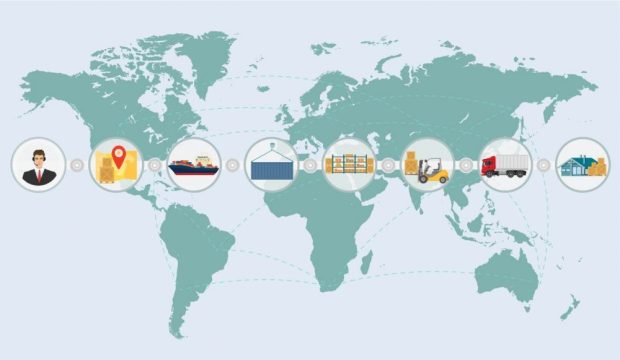Supply Chains: Global, Digital And Simplified

The world is growing ever more interconnected, to be sure, including within commerce, now a 24/7 endeavor for firms in almost any industry.
And as companies large and small extend their markets beyond domestic ones, finding new audiences across borders, supply chains — both digital and physical — are getting longer, not shorter, and are becoming more complex to manage.
To that end, ModusLink Corp., wholly owned by ModusLink Global Solutions, earlier this month debuted its Financial Management Services solution geared toward simplifying some of those complexities. The offering focuses on secure B2B payments and ensuring that companies are in sync with regulatory and compliance mandates in each new region they enter.
In an interview with PYMNTS, Erik Hiddes, manager, FMS at ModusLink, said that companies eyeing new markets must take into account the issues that come with scaling a business and with managing supply chains both digital and physical — the overarching goal of the company should be that “we are facing the hurdles for them.”
The company has estimated that the ramp up into a new market can be a sizable undertaking, with the process taking between three to five years. With ModusLink, such endeavors can be shortened to three to six months. In one example offered to PYMNTS, a single eCommerce company was able to bring operations to 17 countries in a four-month timeframe.
For any company to reach a new audience, each market presents its own challenges. As Hiddes noted, supply chain management also includes tax issues, which can be knotty ones for companies dealing with new countries. Each country has its own set of value-added taxes (VAT) or goods and services taxes (GST), and tax laws can be in flux. In addition, there are import and export tariffs with which to grapple.
By enlisting technology and fulfilment services via ModusLink, the executive said, “we take over … the registration … and have software that calculates the correct taxes and surtaxes.” For those firms trafficking in physical goods across borders in eCommerce, managing shipping costs is paramount, and those costs are paid in local currencies. (The company offers its services in more than 160 countries.)
Tax and logistics issues aside, effective supply chain solutions also mean getting paid on time. Hiddes said that end consumers, of course, opt to pay in their local currencies, so when it comes to eCommerce, firms need to be able to set up operations to accept multiple currencies, mindful of preferred payment methods tied to each locale (with presence across geographies, Hiddes said that ModusLink has the ability to help smooth that process).
In reference to vendor and supply chain payments done across the platform, 99 percent of business is always done on terms, Hiddes told PYMNTS. Across that supply chain, as businesses interact with one another across currencies and time zones, eInvoicing has been gaining traction.
He noted that for his own firm, this feature has been in existence for about five years in an effort to become greener, “to be more efficient … and think of the environment.” Hiddes told PYMNTS that “what we are creating is an eInvoice per country, so that each [company] has its own template which is set up in their own language,” and which complies with requirements in each market. As business is conducted across the company’s ERP [enterprise resource planning) system, PDFs and invoices are automatically sent out to the end customer.
Enlisting other services through supply chain and invoice management also helps firms deal with late payments as they cross borders. Hiddes told PYMNTS that the recently debuted Financial Management Services also offers credit and collections along its continuum of B2B services focused on local languages and with employees based close to those new markets in, say, Singapore or Europe. There are also options to put in place strict credit limits that will prohibit any more shipments to corporate customers on a supply chain until invoices are paid.
In many cases, the eCommerce model is a subscription one, and it’s a valuable one based on recurring revenues, with lures such as free shipping. Behind the scenes lie the logistics of order processing, government reporting and even returns management. Hiddes told PYMNTS its own subscription solution helps manage that process across a variety of payment options spanning PayPal, credit cards and local preferred methods, with subscription orders processed via tokens, which enhances security. For the merchant itself, software helps source materials and manage packing and shipping, among other functions.